|

Samaria
Gorge
The Samaria Gorge,
at 17 kilometers (10
½ miles),
is the longest gorge in Europe. It was declared a National
Park in order to protect its rare flora and fauna, in
particular it is the only mainland refuge of the long-horned
Cretan wild
ibex called "kri-kri"
or the "wild one" by locals. Starting from Xylóskalo,
44 km (27 miles) south of Chania in west
Crete, a
well trodden trail leads down an 18 km (11 mile) course to
the seaside village of Agía Rouméli. The descent into the
gorge takes from 5-7 hours. Crossing the gorge, also called
the "Farangas" by the locals, is only allowed from
the beginning of May to the end of October. During the rest
of the year, the melting snows on the high walls of the
gorge and the rains raise the level of its innocent stream
and turn it into a torrent. Halfway through the gorge lies
the old settlement of Samaria where a few families of
woodcutters used to live. It was abandoned a few years
after the gorge was declared a National Park (1962) and is
now home to a warden's station. The
small Byzantine church of Saint Mary the Egyptian is located
there. The name "Samaria" comes from a
corrupt form of the name of the church: Ossia Maria -
Siamaria - Samaria.
Click on the thumbnails below in order to see pictures of the Samaria Gorge. Use your browser's back button
to return to this page.



|
|
|
|
|
 The
descent through the gorge begins at Xylóskalo ("wooden
stairway"), a zigzag, stepped path with wooden handrails located on the southern
lip of the Omalós plain that drops a staggering 1,000 meters (3,280 feet)
in the first 2 km (1 mile) of the walk. On this spot there was once a wooden stairway to
facilitate the descent which is how the place got its name. The
descent through the gorge begins at Xylóskalo ("wooden
stairway"), a zigzag, stepped path with wooden handrails located on the southern
lip of the Omalós plain that drops a staggering 1,000 meters (3,280 feet)
in the first 2 km (1 mile) of the walk. On this spot there was once a wooden stairway to
facilitate the descent which is how the place got its name.
|
|
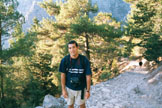 The
wild beauty of the Omalós plateau. The descent at first is through almost alpine
scenery: pine forest, wild flowers and very un-Cretan greenery. The
wild beauty of the Omalós plateau. The descent at first is through almost alpine
scenery: pine forest, wild flowers and very un-Cretan greenery.
|
|
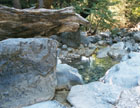 A
little stream, which becomes a raging river in the winter, flows down the
middle of the gorge. A
little stream, which becomes a raging river in the winter, flows down the
middle of the gorge.
|
|
|
|
|
|
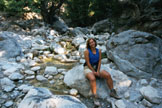 A
rocky stream. A
rocky stream.
|
|
 The
thousands of
trail markers The
thousands of
trail markers |
|
 The
bridge leading into the village of Samaria. The
bridge leading into the village of Samaria. |
|
|
|
|
|
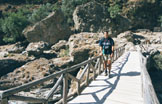 The
bridge The
bridge |
|
 A
kri-kri. The Cadogan guide to the Greek Islands states that
"Although the Gorge is the last refuge of the kri-kri... no one ever
sees one anymore; the few that have survived the 1993 epidemic of killer
ticks, or korpromantakes, are shy of the hordes." Hmmm... glad
to see the guide was wrong... or perhaps this kri-kri didn't get the memo?
J A
kri-kri. The Cadogan guide to the Greek Islands states that
"Although the Gorge is the last refuge of the kri-kri... no one ever
sees one anymore; the few that have survived the 1993 epidemic of killer
ticks, or korpromantakes, are shy of the hordes." Hmmm... glad
to see the guide was wrong... or perhaps this kri-kri didn't get the memo?
J |
|
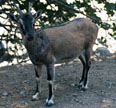 Kri-kri
are found in only a few areas of Crete, notably the Samaria Gorge. They
are thought to be truly wild relatives of the all-too-numerous feral goats
that are found throughout the Mediterranean region, as well as other parts
of the world. They are nimble and sure-footed on rugged terrain. Kri-kri
are found in only a few areas of Crete, notably the Samaria Gorge. They
are thought to be truly wild relatives of the all-too-numerous feral goats
that are found throughout the Mediterranean region, as well as other parts
of the world. They are nimble and sure-footed on rugged terrain. |
|
|
|
|
|
 Our
friendly kri-kri. Mature
adults have attractively marked coats and horns with three rings along
their length. This one appears to be a young one. Our
friendly kri-kri. Mature
adults have attractively marked coats and horns with three rings along
their length. This one appears to be a young one. |
|
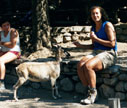 The
"shy and ellusive" kri-kri joined me for lunch, going as far as
putting his (her?) hooves on my lap and eating out of my hand. The
"shy and ellusive" kri-kri joined me for lunch, going as far as
putting his (her?) hooves on my lap and eating out of my hand. |
|
 Further
down the gorge, the path levels out and the gorge walls start to close
in. Further
down the gorge, the path levels out and the gorge walls start to close
in. |
|
|
|
|
|
 More
rocks and stream... we saw a lot of rocks. More
rocks and stream... we saw a lot of rocks. |
|
 The
towering walls of the gorge The
towering walls of the gorge |
|
 At
12 km (7 miles) along the gorge, the route squeezes between two sheer rock
walls that rise 300 meters (almost 1,000 feet) on either side of a passage only 3 meters
(9 feet) wide called Sidirósportes (Iron Gates). At
12 km (7 miles) along the gorge, the route squeezes between two sheer rock
walls that rise 300 meters (almost 1,000 feet) on either side of a passage only 3 meters
(9 feet) wide called Sidirósportes (Iron Gates). |
|
|
|
|
|
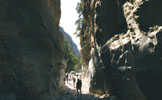 The
famous Iron Gates with Jeff's silhouette for scale. The
famous Iron Gates with Jeff's silhouette for scale. |
|
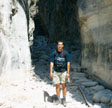 The
Iron Gates from the other (southern) side. The
Iron Gates from the other (southern) side. |
|
 The
southern side of the Iron Gates The
southern side of the Iron Gates |
|
|
|
|
|
|
|
 An
interesting looking flower that we saw many times in the gorge.
Thanks to Ron Greenfield at OurCrete.co.uk,
I now know that this plant is locally known as Latzuni, the squill. It
grows everywhere on the island, the flower appearing before the large
strap-like leaves. It was a fertility plant for the Minoans and still is
for some Greeks, the large bulb being put outside homes on Jan
1st (St Basil). An
interesting looking flower that we saw many times in the gorge.
Thanks to Ron Greenfield at OurCrete.co.uk,
I now know that this plant is locally known as Latzuni, the squill. It
grows everywhere on the island, the flower appearing before the large
strap-like leaves. It was a fertility plant for the Minoans and still is
for some Greeks, the large bulb being put outside homes on Jan
1st (St Basil). |
|
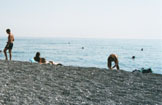 The
reward at the end of the trip through the gorge is a dip in the Libyan
Sea. About 1.5 kms from the exit of the gorge is Agía
Rouméli, a seaside
settlement built over the ancient city of Tarra, where Apollo hid from the
wrath of Zeus after slaying the Python at Delphi. The
reward at the end of the trip through the gorge is a dip in the Libyan
Sea. About 1.5 kms from the exit of the gorge is Agía
Rouméli, a seaside
settlement built over the ancient city of Tarra, where Apollo hid from the
wrath of Zeus after slaying the Python at Delphi. |
|
|
|
|
|
© All pictures are Copyright 2000 Grisel Gonzalez and Jeff
Prosise
|